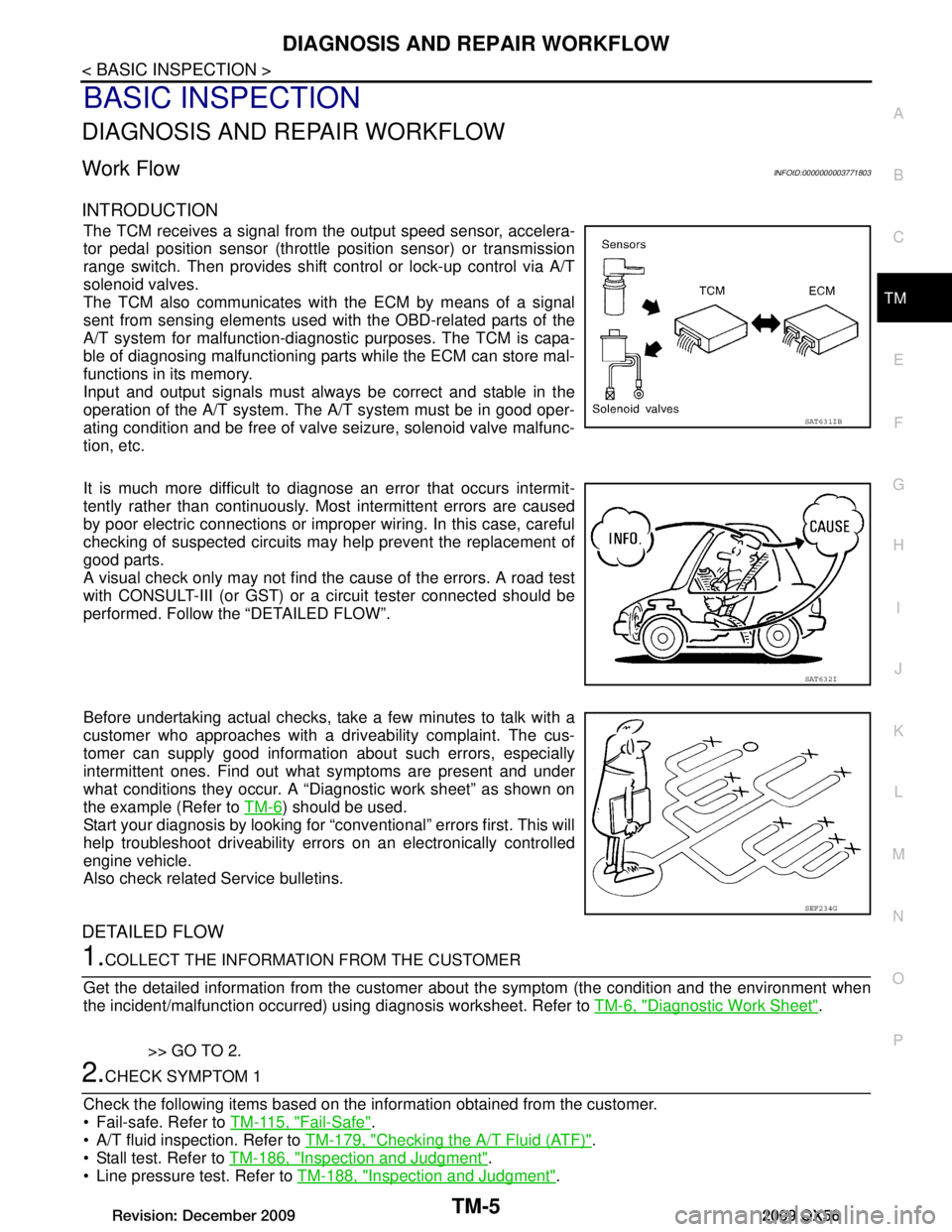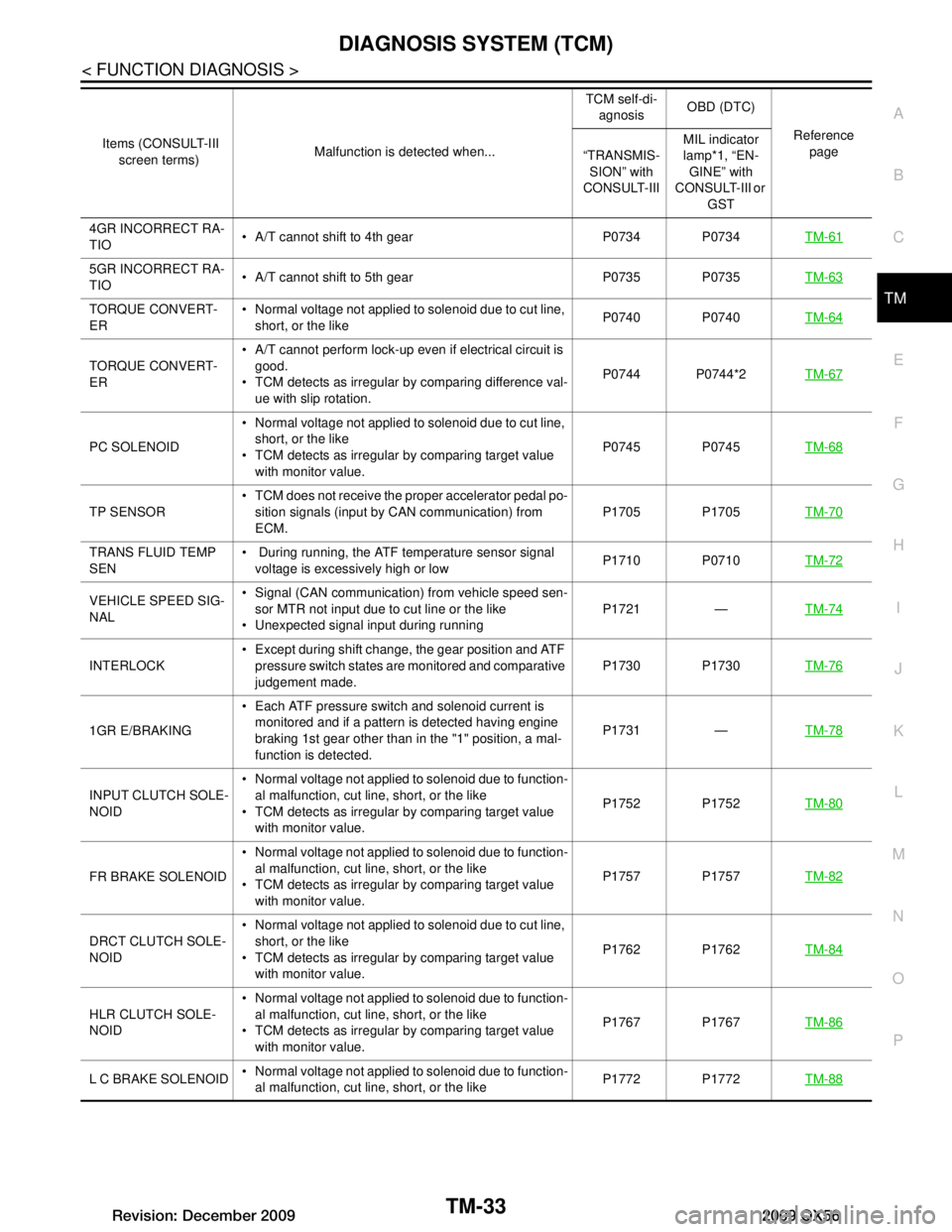2009 INFINITI QX56 electric
[x] Cancel search: electricPage 3632 of 4171

PRECAUTIONSSTR-3
< PRECAUTION >
C
DE
F
G H
I
J
K L
M A
STR
NP
O
5. When the repair work is completed, return the ignition switch to the
″LOCK ″ position before connecting
the battery cables. (At this time, the steering lock mechanism will engage.)
6. Perform a self-diagnosis check of al l control units using CONSULT-III.
Precaution for Power Generation Variable Voltage Control SystemINFOID:0000000003771784
CAUTION:
For this model, the battery current sensor that is installed to the negative battery cable measures the
charging/discharging current of the battery and performs various engine controls. If an electrical com-
ponent is connected directly to the negative battery terminal, the current flowing through that compo-
nent will not be measured by the battery current sensor. This condition may cause a malfunction of
the engine control system and battery discharge m ay occur. Do not connect an electrical component
or ground wire directly to the battery terminal.
Revision: December 20092009 QX56
Page 3638 of 4171

STARTING SYSTEMSTR-9
< FUNCTION DIAGNOSIS >
C
DE
F
G H
I
J
K L
M A
STR
NP
O
Component DescriptionINFOID:0000000003771791
Component part
Description
TCM TCM supplies power to the starter relay inside the IPDM E/R when
the selector lever is shifted to the P or N position.
BCM BCM sends a starter request signal to the CPU of the IPDM E/R
over the CAN communication lines.
IPDM E/R CPU inside IPDM E/R operates the starter relay at the request of
the BCM over the CAN communication lines.
Starter motor The starter motor plunger closes and the motor is supplied with
battery power, which in turn cranks the engine, when the “S” ter-
minal is supplied with electric power.
Revision: December 20092009 QX56
Page 3653 of 4171

DIAGNOSIS AND REPAIR WORKFLOWTM-5
< BASIC INSPECTION >
CEF
G H
I
J
K L
M A
B
TM
N
O P
BASIC INSPECTION
DIAGNOSIS AND REPAIR WORKFLOW
Work FlowINFOID:0000000003771803
INTRODUCTION
The TCM receives a signal from the output speed sensor, accelera-
tor pedal position sensor (throttle position sensor) or transmission
range switch. Then provides shift c ontrol or lock-up control via A/T
solenoid valves.
The TCM also communicates with the ECM by means of a signal
sent from sensing elements used wit h the OBD-related parts of the
A/T system for malfunction-diagnostic purposes. The TCM is capa-
ble of diagnosing malfunctioning parts while the ECM can store mal-
functions in its memory.
Input and output signals must always be correct and stable in the
operation of the A/T system. T he A/T system must be in good oper-
ating condition and be free of valve seizure, solenoid valve malfunc-
tion, etc.
It is much more difficult to diagnose an error that occurs intermit-
tently rather than continuously. Most intermittent errors are caused
by poor electric connections or impr oper wiring. In this case, careful
checking of suspected circuits may help prevent the replacement of
good parts.
A visual check only may not find t he cause of the errors. A road test
with CONSULT-III (or GST) or a circuit tester connected should be
performed. Follow the “DETAILED FLOW”.
Before undertaking actual checks, take a few minutes to talk with a
customer who approaches with a driveability complaint. The cus-
tomer can supply good information about such errors, especially
intermittent ones. Find out what symptoms are present and under
what conditions they occur. A “Diagnostic work sheet” as shown on
the example (Refer to TM-6
) should be used.
Start your diagnosis by looking for “conventional” errors first. This will
help troubleshoot driveability errors on an electronically controlled
engine vehicle.
Also check related Service bulletins.
DETAILED FLOW
1.COLLECT THE INFORMATION FROM THE CUSTOMER
Get the detailed information from the customer about the symptom (the condition and the environment when
the incident/malfunction occurred) using diagnosis worksheet. Refer to TM-6, "Diagnostic Work Sheet"
.
>> GO TO 2.
2.CHECK SYMPTOM 1
Check the following items based on the in formation obtained from the customer.
Fail-safe. Refer to TM-115, "Fail-Safe"
.
A/T fluid inspection. Refer to TM-179, "Checking the A/T Fluid (ATF)"
.
Stall test. Refer to TM-186, "Inspection and Judgment"
.
Line pressure test. Refer to TM-188, "Inspection and Judgment"
.
SAT631IB
SAT632I
SEF234G
Revision: December 20092009 QX56
Page 3677 of 4171

A/T SHIFT LOCK SYSTEMTM-29
< FUNCTION DIAGNOSIS >
CEF
G H
I
J
K L
M A
B
TM
N
O P
A/T SHIFT LOCK SYSTEM
System DescriptionINFOID:0000000003771817
The electrical key interlock mechanism also operates as a shift lock: With the ignition switch turned to ON, the selector lever cannot be shifted from “P” (parking) to any other
position unless the brake pedal is depressed.
With the key removed, the selector lever c annot be shifted from “P” to any other position.
The key cannot be removed unless the selector lever is placed in “P”.
The shift lock and key interlock mechanisms are controlled by the ON-OFF operation of the shift lock sole-
noid and by the operation of the rotator and slider located inside the key cylinder, respectively.
Component Parts LocationINFOID:0000000003771818
LCIA0326E
Revision: December 20092009 QX56
Page 3681 of 4171

DIAGNOSIS SYSTEM (TCM)TM-33
< FUNCTION DIAGNOSIS >
CEF
G H
I
J
K L
M A
B
TM
N
O P
4GR INCORRECT RA-
TIO A/T cannot shift to 4th gear P0734 P0734
TM-61
5GR INCORRECT RA-
TIO A/T cannot shift to 5th gear P0735 P0735
TM-63
TORQUE CONVERT-
ER Normal voltage not applied to solenoid due to cut line,
short, or the like P0740 P0740
TM-64
TORQUE CONVERT-
ER A/T cannot perform lock-up even if electrical circuit is
good.
TCM detects as irregular by comparing difference val-
ue with slip rotation. P0744 P0744*2
TM-67
PC SOLENOID Normal voltage not applied to solenoid due to cut line,
short, or the like
TCM detects as irregular by comparing target value
with monitor value. P0745 P0745
TM-68
TP SENSOR TCM does not receive the proper accelerator pedal po-
sition signals (input by CAN communication) from
ECM. P1705 P1705
TM-70
TRANS FLUID TEMP
SEN During running, the ATF temperature sensor signal
voltage is excessively high or low P1710 P0710
TM-72
VEHICLE SPEED SIG-
NAL Signal (CAN communication) from vehicle speed sen-
sor MTR not input due to cut line or the like
Unexpected signal input during running P1721 —
TM-74
INTERLOCK Except during shift change, the gear position and ATF
pressure switch states are monitored and comparative
judgement made. P1730 P1730
TM-76
1GR E/BRAKING Each ATF pressure switch and solenoid current is
monitored and if a pattern is detected having engine
braking 1st gear other than in the "1" position, a mal-
function is detected. P1731 —
TM-78
INPUT CLUTCH SOLE-
NOID Normal voltage not applied to solenoid due to function-
al malfunction, cut line, short, or the like
TCM detects as irregular by comparing target value
with monitor value. P1752 P1752
TM-80
FR BRAKE SOLENOID Normal voltage not applied to solenoid due to function-
al malfunction, cut line, short, or the like
TCM detects as irregular by comparing target value
with monitor value. P1757 P1757
TM-82
DRCT CLUTCH SOLE-
NOID Normal voltage not applied to solenoid due to cut line,
short, or the like
TCM detects as irregular by comparing target value
with monitor value. P1762 P1762
TM-84
HLR CLUTCH SOLE-
NOID Normal voltage not applied to solenoid due to function-
al malfunction, cut line, short, or the like
TCM detects as irregular by comparing target value
with monitor value. P1767 P1767
TM-86
L C BRAKE SOLENOID Normal voltage not applied to solenoid due to function-
al malfunction, cut line, short, or the like P1772 P1772
TM-88
Items (CONSULT-III
screen terms) Malfunction is detected when... TCM self-di-
agnosis OBD (DTC)
Reference page
“TRANSMIS-
SION” with
CONSULT-III MIL indicator
lamp*1, “EN-
GINE” with
CONSULT-III or
GST
Revision: December 20092009 QX56
Page 3702 of 4171

TM-54
< COMPONENT DIAGNOSIS >
P0731 1GR INCORRECT RATIO
P0731 1GR INCORRECT RATIO
DescriptionINFOID:0000000003771865
This malfunction is detected when the A/T does not shift into 1GR position as instructed by TCM. This is not
only caused by electrical malfunction (circuits open or shorted) but also by mechanical malfunction such as
control valve sticking, improper solenoid valve operation.
On Board Diagn osis LogicINFOID:0000000003771866
This is an OBD-II self-diagnostic item.
Diagnostic trouble code “P0731” is detected when TCM detec ts any inconsistency in the actual gear ratio.
Possible CauseINFOID:0000000003771867
Harness or connectors
(Solenoid circuits are open or shorted.)
Input clutch solenoid valve
Front brake solenoid valve
Direct clutch solenoid valve
High and low reverse clutch solenoid valve
Each clutch
Hydraulic control circuit
DTC Confirmation ProcedureINFOID:0000000003771868
CAUTION:
Always drive vehicle at a safe speed.
NOTE:
If “DTC Confirmation Procedure” has been previously performed, alw ays turn ignition switch OFF and
wait at least 10 seconds before performing the next test.
After the repair, perform the following proc edure to confirm the malfunction is eliminated.
WITH CONSULT-III
1. Start the engine and select “DATA MONITOR” mode for “TRANSMISSION” with CONSULT-III.
2. Make sure that “ATF TEMP 1” is within the following range. ATF TEMP 1: 20 °C – 140 °C
If out of range, drive vehicle to warm ATF or stop engine to cool ATF.
3. Select “1ST GR FNCTN P0731” of “DTC WORK SUPPORT” mode for “TRANSMISSION” with CON-
SULT-III.
4. Drive vehicle and maintain the following conditions.
VEHICLE SPEED: 10 km/h (6 MPH) or more
ACCELE POSI: 0.6/8 or more
ENGINE SPEED: INPUT SPEED − 50 rpm or more
INPUT SPEED: 300 rpm or more
GEAR: “1” position
MANU MODE SW: ON
5. Keep the current driving status for at least 5 consecutive seconds if CONSULT-III screen changes from
“OUT OF CONDITION” to “TESTING”.
CAUTION:
If “TESTING” does not ap pear on CONSULT-III for a long ti me, select “SELF-DIAG RESULTS”. In
case a 1st trip DTC other than P0731 is shown, refer to “ TM-117, "DTC No. Index"
”.
If “COMPLETED RESULT NG” is detected, go to TM-55, "Diagnosis Procedure"
.
If “STOP VEHICLE” is detect ed, go to the following step.
6. Stop vehicle.
7. Drive vehicle in “D” position allowing it to shif t from 1GR to 5GR gear and check shift timing and shift
shock.
- Touch “OK” to complete the inspection when normally shifted from the 1GR to 5GR.
- Touch “NG” when an unusual shift shock, etc. occurs in spite of shifting from the 1GR to 5GR. Go to TM-
190, "Description".
- Perform TM-32, "CONSULT-III Function (TRANSMISSION)"
when not shifted from the 1GR to 5GR. (Nei-
ther “OK” nor “NG” are indicated.)
Revision: December 20092009 QX56
Page 3704 of 4171

TM-56
< COMPONENT DIAGNOSIS >
P0732 2GR INCORRECT RATIO
P0732 2GR INCORRECT RATIO
DescriptionINFOID:0000000003771870
This malfunction is detected when the A/T does not shift into 2GR position as instructed by TCM. This is not
only caused by electrical malfunction (circuits open or shorted) but also by mechanical malfunction such as
control valve sticking, improper solenoid valve operation.
On Board Diagn osis LogicINFOID:0000000003771871
This is an OBD-II self-diagnostic item.
Diagnostic trouble code “P0732” detected when TCM detects any inconsistency in the actual gear ratio.
Possible CauseINFOID:0000000003771872
Harness or connectors
(Solenoid circuits are open or shorted.)
Input clutch solenoid valve
Front brake solenoid valve
Direct clutch solenoid valve
High and low reverse clutch solenoid valve
Each clutch
Hydraulic control circuit
DTC Confirmation ProcedureINFOID:0000000003771873
CAUTION:
Always drive vehicle at a safe speed.
NOTE:
If “DTC Confirmation Procedure” has been previously performed, alw ays turn ignition switch OFF and
wait at least 10 seconds before performing the next test.
After the repair, perform the following proc edure to confirm the malfunction is eliminated.
WITH CONSULT-III
1. Start the engine and select “DATA MONITOR” mode for “TRANSMISSION” with CONSULT-III.
2. Make sure that “ATF TEMP 1” is within the following range. ATF TEMP 1: 20 °C – 140 °C
If out of range, drive vehicle to warm ATF or stop engine to cool ATF.
3. Select “2ND GR FNCTN P0732” of “DTC WORK SUPPORT” mode for “TRANSMISSION” with CON-
SULT-III.
4. Drive vehicle and maintain the following conditions.
VEHICLE SPEED: 10 km/h (6 MPH) or more
ACCELE POSI: 0.6/8 or more
ENGINE SPEED: INPUT SPEED − 50 rpm or more
INPUT SPEED: 300 rpm or more
GEAR: “2” position
MANU MODE SW: ON
5. Keep the current driving status for at least 5 consecutive seconds if CONSULT-III screen changes from
“OUT OF CONDITION” to “TESTING”.
CAUTION:
If “TESTING” does not ap pear on CONSULT-III for a long ti me, select “SELF-DIAG RESULTS”. In
case a 1st trip DTC other than P0732 is shown, refer to “ TM-117, "DTC No. Index"
”.
If “COMPLETED RESULT NG” is detected, go to TM-57, "Diagnosis Procedure"
.
If “STOP VEHICLE” is detect ed, go to the following step.
6. Stop vehicle.
7. Drive vehicle in “D” position allowing it to shift from 1GR to 5GR and check shift timing and shift shock.
- Touch “OK” to complete the inspection when normally shifted from the 1GR to 5GR.
- Touch “NG” when an unusual shift shock, etc. occurs in spite of shifting from the 1GR to 5GR. Go to TM-
190, "Description".
- Perform TM-32, "CONSULT-III Function (TRANSMISSION)"
when not shifted from the 1GR to 5GR. (Nei-
ther “OK” nor “NG” are indicated.)
Revision: December 20092009 QX56
Page 3706 of 4171

TM-58
< COMPONENT DIAGNOSIS >
P0733 3GR INCORRECT RATIO
P0733 3GR INCORRECT RATIO
DescriptionINFOID:0000000003771875
This malfunction is detected when the A/T does not shift into 3GR position as instructed by TCM. This is not
only caused by electrical malfunction (circuits open or shorted) but also by mechanical malfunction such as
control valve sticking, improper solenoid valve operation.
On Board Diagn osis LogicINFOID:0000000003771876
This is an OBD-II self-diagnostic item.
Diagnostic trouble code “P0733” is detected when TCM detec ts any inconsistency in the actual gear ratio.
Possible CauseINFOID:0000000003771877
Harness or connectors
(Solenoid circuits are open or shorted.)
Input clutch solenoid valve
Front brake solenoid valve
Direct clutch solenoid valve
High and low reverse clutch solenoid valve
Each clutch
Hydraulic control circuit
DTC Confirmation ProcedureINFOID:0000000003771878
CAUTION:
Always drive vehicle at a safe speed.
NOTE:
If “DTC Confirmation Procedure” has been previously performed, alw ays turn ignition switch OFF and
wait at least 10 seconds before performing the next test.
After the repair, perform the following proc edure to confirm the malfunction is eliminated.
WITH CONSULT-III
1. Start the engine and select “DATA MONITOR” mode for “TRANSMISSION” with CONSULT-III.
2. Make sure that “ATF TEMP 1” is within the following range. ATF TEMP 1: 20 °C – 140 °C
If out of range, drive vehicle to warm ATF or stop engine to cool ATF.
3. Select “3RD GR FNCTN P0733” of “DTC WORK SUPPORT” mode for “TRANSMISSION” with CON-
SULT-III.
4. Drive vehicle and maintain the following conditions.
VEHICLE SPEED: 10 km/h (6 MPH) or more
ACCELE POSI: 0.6/8 or more
ENGINE SPEED: INPUT SPEED − 50 rpm or more
INPUT SPEED: 300 rpm or more
GEAR: “3” position
MANU MODE SW: ON
5. Keep the current driving status for at least 5 consecutive seconds if CONSULT-III screen changes from
“OUT OF CONDITION” to “TESTING”.
CAUTION:
If “TESTING” does not ap pear on CONSULT-III for a long ti me, select “SELF-DIAG RESULTS”. In
case a 1st trip DTC other than P0732 is shown, refer to “ TM-117, "DTC No. Index"
”.
If “COMPLETED RESULT NG” is detected, go to TM-59, "Diagnosis Procedure"
.
If “STOP VEHICLE” is detect ed, go to the following step.
6. Stop vehicle.
7. Drive vehicle in “D” position allowing it to shift from 1GR to 5GR and check shift timing and shift shock.
- Touch “OK” to complete the inspection when normally shifted from the 1GR to 5GR.
- Touch “NG” when an unusual shift shock, etc. occurs in spite of shifting from the 1GR to 5GR. Go to TM-
190, "Description".
- Perform TM-32, "CONSULT-III Function (TRANSMISSION)"
when not shifted from the 1GR to 5GR. (Nei-
ther “OK” nor “NG” are indicated.)
Revision: December 20092009 QX56